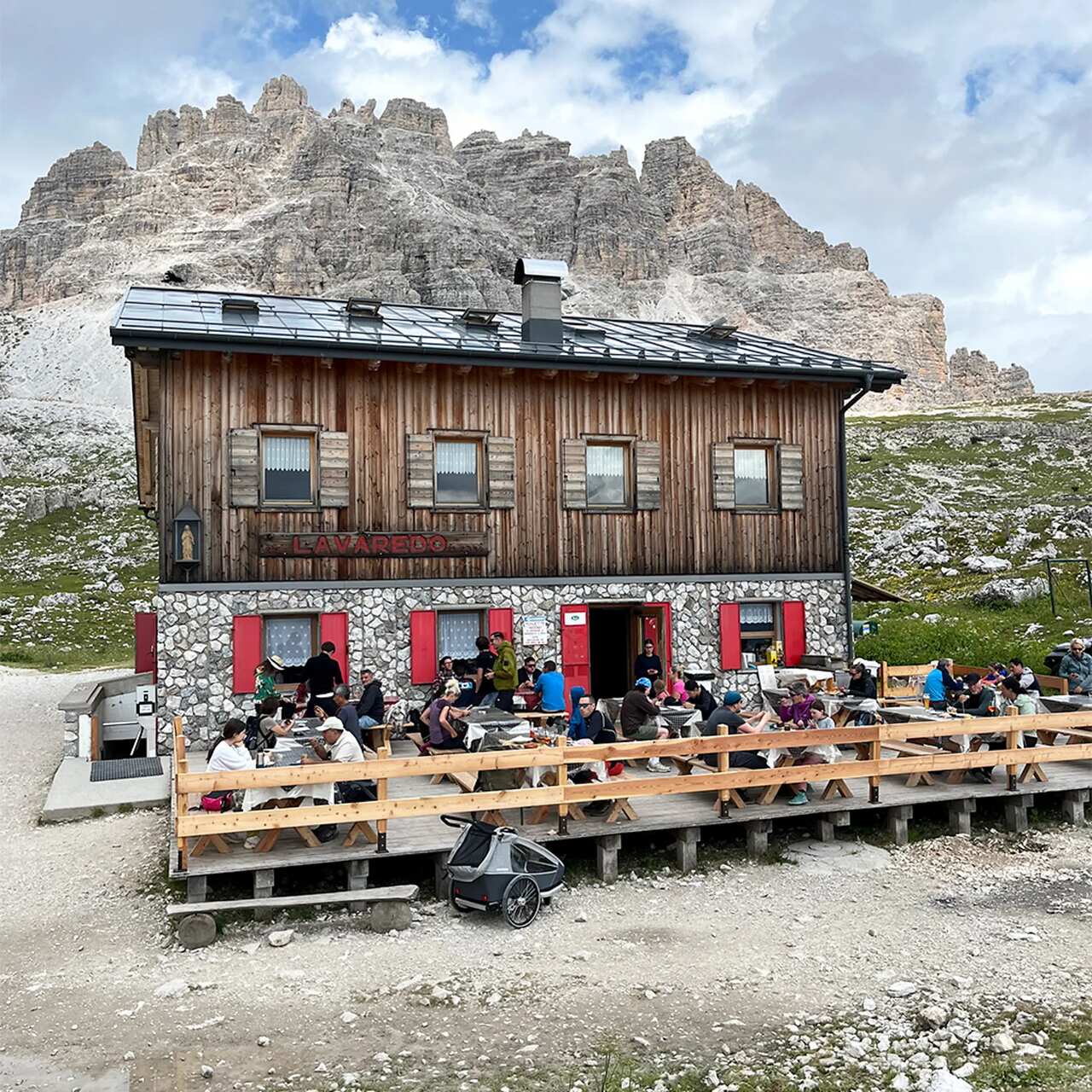The European region with a 'split personality'
BBC | 18.11.2025 20:00
Straddling Italy and Austria, the Dolomite Mountains blend three languages, two identities and one breathtaking landscape – but their delicate balance is being tested
In the shadow of the Tre Cime di Lavaredo, the old military road from Rifugio Auronzo led me along a clifftop path marked by rockfalls. On an exposed curve was a lonely stone chapel, the Maria Ausiliatrice Madonna della Croda Church. Built in 1917, I read. A few metres away was a monument built by the Bersaglieri, Italy's elite infantry corps, to commemorate the fallen during World War One. It was imbued with a sense of loss, and I ran my hands over the cold stone.
Among the rubble nearby was another monument. But this one was smaller and dedicated to Austrian mountaineer Paul Grohmann, who, 60 years before, had made the first ascent of Cima Grande, the battlement-like mountain I was standing below. It was a quiet celebration of bygone Austrian heroism.
Tragedy. Triumph. The complicated history of these borderland mountains was suddenly tangible in the rocks at my feet.
Once, the Tre Cime di Lavaredo (also known as the Drei Zinnen) and the Sexten Dolomites were part of the Austro-Hungarian Empire. For more than 550 years, until 1918, the regions that now form Trentino-Alto Adige/South Tyrol, Belluno in Veneto and part of Friuli-Venezia Giulia belonged to the Habsburgs. Since their transfer in 1919 as part of territorial gains following the end of WW1, they have been ruled by Italy.
It has been said that the Dolomites have a curiously dual personality. It's Austria, but Italy. Italy, but Austria. Then, this heritage is interwoven with a third cultural and linguistic identity: Ladin. Hiking is largely a pursuit to quiet the mind, but in the Dolomites it is different. A short walk can sometimes feel like walking through three countries at once.
"Our mountains have a split personality – particularly in the South Tyrolean part of the Dolomites," said Agustina Lagos Marmol, founder of specialist tour operator Dolomite Mountains. "But that suggests division. Our three languages have equal status [under the region's Autonomy Statute (1972)], and everyday life reflects these overlapping influences, from architecture to dialects to cultural attitudes. Our cuisine, for instance, seamlessly blends Italian flair with Tyrolean heartiness and Ladin traditions. That sets it apart from the more uniform, traditionally Germanic Alpine fare found just across the border [in Austria]."
If you join the hikers in the Tre Cime di Lavaredo, you'll notice that too. When I arrived at Refugio Lavaredo, there was a sense of shared purpose and communality with hikers of all ages and languages sharing food, beer, wine and aperitifs across long tables, both inside and out. They were connected to the landscape – the steepled ridges, the furious clouds, the mountains watching up there – but, more importantly, to each other. It was more social than functional; the polar opposite of my experiences exploring quieter mountain refuges in Austria.
Our mountains have a split personality – particularly in the South Tyrolean part of the Dolomites – Agustina Lagos Marmol
The flipside is the Unesco World Heritage site is populated with the world's highest concentration of via ferrata – high-altitude "iron roads" equipped with climbing aids and rusting steel cables – where you are on your own. Here, it's up to you to scramble up metal ladders and rungs, to think carefully about what you're doing, not to step into thin air.
On paper, the point is to see the Dolomites in a way few do. But it is also to follow in the footsteps of the soldiers who fought at altitudes of up to 3,600m on the frontline of these WW1 borderlands. Hundreds of via ferrata routes were built to move Italian troops, explosives and weapons through the treacherous terrain, and this area remains deeply meaningful to local communities as places of education, reconciliation and memory.

Today, there are 13 via ferrata trails to follow in the Tre Cime Nature Park, and these life-size snakes-and-ladders courses are a motivation for so many interactions with the Dolomites away from the crowds. If you have a head for heights, scrambling on designated routes like Torre di Toblin, Severino Casara or De Luca-Innerkofler offer stupendous rewards. As Lagos Marmol told me, they let your imagination run wild.
"Our via ferrata are a defining element of what makes the Dolomites so distinctive within the Alps," she said. "They blend culture, history and adventure in a way few other mountain destinations can. Equally, they are ways of remembering the past, and each climb becomes a journey through both nature and history."
More like this:
In contrast, my next stop was accessible to all: the Anderter Alpe Open Air Museum on Croda Rossa, on the northern side of Tre Cime Nature Park and set above the village of Sexten (Sesto). Visiting its evocative collection of ruined military fortifications, aerial cableways and cannon bunkers was like opening a trapdoor to the early 20th Century. I walked among remains of camps and shelters, trenches and tunnels, high on a mountainside that was not quite the Dolomites, nor Italy, but a battlefront frozen in time. It was spectrally quiet.

Another living-history museum, the Monte Piana Open Air Museum above the neighbouring village of Toblach (Dobbiaco), piqued my curiosity even more. Once an extraordinarily bloody battlefield, it epitomised the dual personality of these once heavily fortified mountains. On the northern flank of the summit, Austrian soldiers held their ground in trenches. To the south, only metres away, the same peak was occupied by Italians. Today, many of the 14,000 soldiers killed are buried below in the village's Sorgenti War Cemetery.
The Tre Cime area remains nostalgic and emotive terrain, that's evident. But it has also become a different sort of battleground in recent years. Outdoor stores are plenty, restaurants sell mountain cuisine – lots of speck and Knödel, polenta and pasta – and authorities are having to deal with a sharp rise in visitor numbers, in part thanks to Instagram and TikTok. Last year, a rock face on the Tre Cime di Lavaredo circuit was defaced with graffiti reading "Tourists Go Home".
According to local municipalities, the Tre Cime di Lavaredo attracts up to 14,000 daily visitors in the summer months. Bigger picture, South Tyrol recorded around 37 million overnight stays in 2024. That means congested roads, haphazard parking, crowded trails and little respite for its roughly 540,000 residents.
As visitor numbers have accelerated, so too have soft measures to police and protect the area from overtourism. The toll-gated road to the Tre Cime di Lavaredo, which abruptly ends at a ramshackle parking lot at 2,333m beneath the Rifugio Auronzo, has long existed as a defence, but new regulations were introduced this summer. Now, visitors arriving by vehicle must register in advance and reserve an entry time (from €40). Likewise, Lago di Braies, an unfathomably blue mountain lake near Dobbiaco, has surged in popularity. Access restrictions mean a pre-booked parking spot or shuttle bus service is essential.

Are such measures working? Absolutely, Curti Covi, sustainability manager of the 3 Zinnen Dolomites region based in Innichen (San Candido), told me. "Before, the Tre Cime di Lavaredo access road was chaotic. A free-for-all. At peak times, you'd have to sit in a queue for hours. It's progress, but there are more hotspots where we need to introduce caps, registrations and fees to finance all the services visitors need."
Chiefly, one of the primary goals of the wider Tre Cime Nature Park is sustainability. Another is keeping control. That means resisting outside influence and keeping businesses in family hands, unlike in so many other Alpine villages. Self-determination, says Covi, is crucial to South Tyrolian and Ladin identity.
"The thought of selling our hotels or businesses to outsiders – it's an alien concept," concluded Covi. "Our valleys are filled with small, tight-knit communities and there's an instinct to survive and thrive in our own way. To remain independent, not influenced by outsiders. It's the biggest challenge we have."
--
If you liked this story, sign up for The Essential List newsletter – a handpicked selection of features, videos and can't-miss news, delivered to your inbox twice a week.









